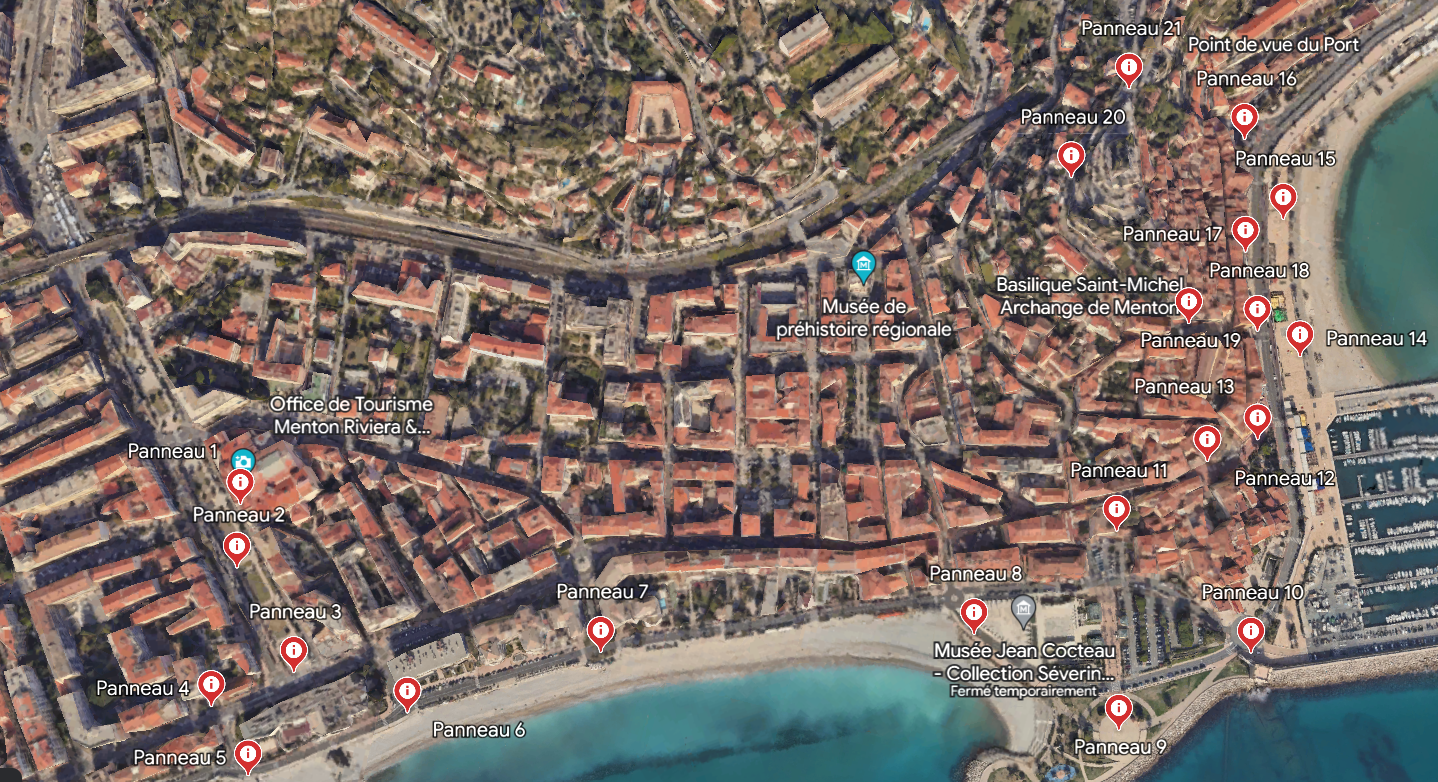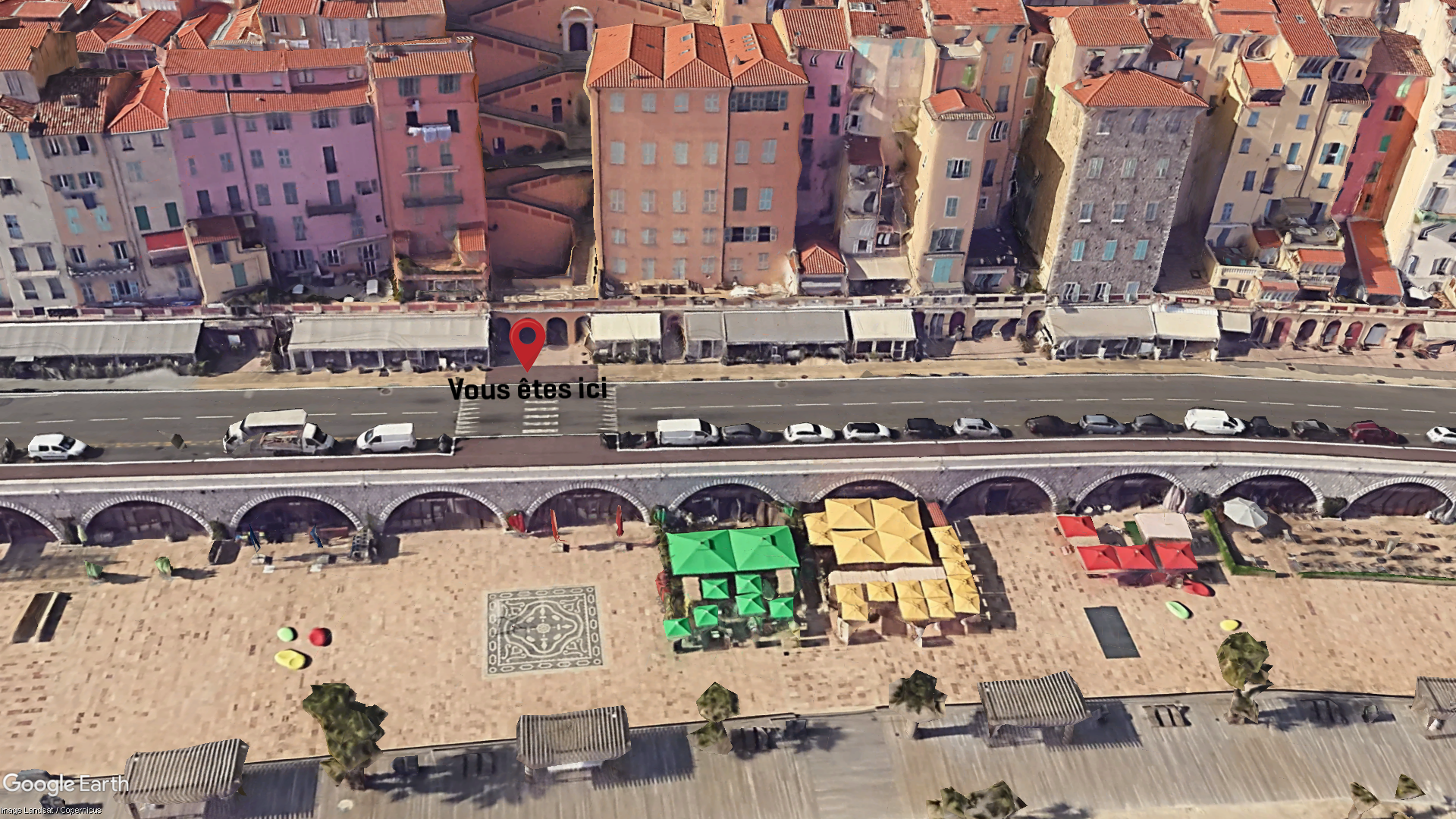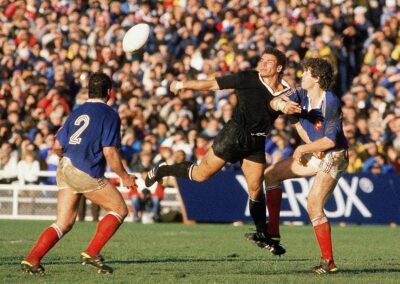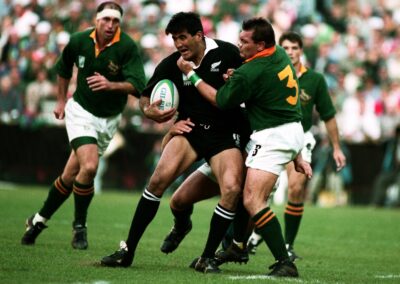18 - Les Coupes du monde de rugby

Version audio
Version texte
18 – Les Coupes du monde de rugby
La première Coupe du monde de rugby
-
En 1982, l’IRB rejette la proposition de Coupe du monde émise par un cabinet de gestion londonien. En 1984, l’IRB accepte que la Nouvelle-Zélande et l’Australie préparent une étude de faisabilité à soumettre l’année suivante.
-
Le Dr. Roger Vanderfield (Australie), président du comité de l’IRB qui se réunit à Paris le 21 mars 1985, « décide d’organiser une Coupe du monde de rugby à titre d’essai ». L’anglais John Kendal-Carpenter est élu président de son comité.
-
La première Coupe du monde se tient en Nouvelle-Zélande et en Australie en 1987. La Nouvelle-Zélande bat la France en finale par le score de 29 à 9, remportant le trophée Webb Ellis pour la première fois.
-
Seize nations sont invitées : la Nouvelle-Zélande, l’Australie, l’Angleterre, l’Écosse, la France, l’Irlande, le Pays de Galles, l’Italie, la Roumanie, le Zimbabwe, l’Argentine, les États-Unis, le Canada, le Japon, les îles Tonga et Fidji participent au tournoi, avec plus de 600 000 spectateurs sur 11 sites (9 en Nouvelle-Zélande et 2 en Australie). Ces rencontres sont diffusées dans 17 pays et regardées par 300 millions de téléspectateurs.
-
La Coupe du monde 1987 est le premier tournoi sportif international de l’histoire à faire des bénéfices dès son début.
Coupe du monde de rugby 1991
-
La deuxième Coupe du monde de rugby qui a lieu en 1991, est organisée conjointement par les Cinq Nations : RFU, SRU, IRFU, WRU et FFR.
-
32 fédérations de l’IRB participent aux tours de qualification organisés pour la première fois. Le processus de qualification démarre en France à Tours en 1989, par un tournoi entre le Danemark, la Suède, Israël et la Suisse.
-
Le tournoi final se déroule sur 19 sites dans 5 pays différents : la France (8), l’Angleterre (4), l’Écosse (1), l’Irlande (2) et le Pays de Galles (4). 16 équipes jouent 32 matchs regardés par 1 million de spectateurs.
-
Le tournoi est diffusé dans 103 pays et regardé par un total de 1,75 milliard de spectateurs.
-
Le principe de sponsor de la Coupe du monde est supprimé et remplacé par un programme de parrainage d’élite regroupant plusieurs partenaires officiels.
-
L’Australie bat l’Angleterre en finale à Twickenham par 12 points à 6, remportant ainsi le titre mondial.
Coupe du monde de rugby 1995 : le jeu devient professionnel
-
La troisième Coupe du monde est organisée pour la première fois dans un seul pays, l’Afrique du Sud. 53 fédérations participent aux tours de qualification et 16 jouent lors du tournoi final qui se déroule sur 9 sites.
-
1,25 million de spectateurs assistent aux matchs, qui sont regardés à la télévision par 2,7 milliards de personnes dans 124 pays.
-
Le tournoi est parrainé par un groupe de sponsors d’élite.
-
Au cours de la finale qui se tient au stade Ellis Park de Johannesburg, l’Afrique du Sud bat la Nouvelle-Zélande 15 à 12 pendant les prolongations. La France bat l’Angleterre au cours des éliminatoires pour la troisième place et remporte son billet pour le tournoi de 1999.
-
C’est après le tournoi, pendant une réunion exceptionnelle à Paris en août 1995, que l’IRB fait du jeu un sport officiel, mettant fin à plus d’un siècle d’amateurisme.
La Coupe du monde de rugby entre dans l’ère professionnelle
-
La Coupe du monde de rugby organisée en 1999 par la Fédération galloise de rugby avec l’aide des cinq autres pays participant au Tournoi des Cinq Nations, est la première compétition professionnelle de l’histoire. Soixante-cinq équipes participent aux éliminatoires. Le nombre d’équipes qualifiées pour la phase finale passe de 16 à 20. Quarante et un matchs sont joués dans 18 stades et suivis par 1,7 million de spectateurs. Le tournoi est diffusé dans 209 pays et suivi par 3 milliards de téléspectateurs. Lors de la finale qui se tient au Millenium Stadium à Cardiff, l’Australie remporte le titre pour la seconde fois en battant la France 35 à 12.
-
Le premier tournoi du nouveau millénaire se déroule en Australie en 2003. Quatre-vingt-deux équipes participent aux éliminatoires, parmi lesquelles 20 atteignent la phase finale organisée dans 11 stades et suivie par 1,95 million de spectateurs à travers l’Australie. Les 48 matchs sont diffusés dans 193 pays à un total de 3,4 milliards de téléspectateurs. Lors de la finale qui se tient au Telstra Stadium à Sydney, l’Angleterre bat l’Australie 20 à 17. Il s’agit de la première équipe de l’hémisphère Nord à s’imposer.
-
Quatre-vingt-quatorze équipes participent aux éliminatoires de la sixième Coupe du monde de rugby qui ont commencé en septembre 2004. La Fédération française de rugby est chargée de l’organisation 2007 de la phase finale au cours de laquelle vingt équipes s’affronteront. 48 matchs sont programmés dans 12 stades, dont 10 en France, 1 au Pays de Galles et 1 en Écosse. Le tournoi est diffusé dans 200 pays et selon les estimations, on s’attend à atteindre une audience cumulée de 4 milliards de téléspectateurs.

Audio version
Text version
18. The Rugby World Cups
The first Rugby World Cup (RWC)
- In 1982, a proposal by a London-based management consultancy for a World Cup tournament was rejected by the IRB. In 1984 the Board agreed that New Zealand and Australia should prepare a RWC feasibility study for consideration the following year.
- On March 21, 1985 the IRB Council Meeting held in Paris under the chairmanship of Dr. Roger Vanderfield of Australia, “resolved to hold a Rugby World Cup tournament on a trial basis.” John Kendal-Carpenter of England was elected Chairman of the RWC Committee.
- The first RWC tournament was held in New Zealand and Australia in 1987. New Zealand defeated France 29-9 in the final to win the Webb Ellis trophy for the first time.
- 16 invited nations: New Zealand, Australia, England, Scotland, France, Ireland, Wales, Italy, Romania, Zimbabwe, Argentina, USA, Canada, Tonga, Japan and Fiji took part in the tournament watched by 600,000 spectators at 11 venues (nine in New Zealand and two in Australia) and broadcast to 17 countries to a cumulative audience of 300 million.
- RWC 1987 was the first international sport tournament in history which made a profit from the outset.
Rugby World Cup 1991
-
The second Rugby World Cup in 1991 was organised jointly by the Five Nations: RFU, SRU, IRFU, WRU and FFR.
-
32 IRB Unions entered the qualifying rounds organised for the first time. The qualifying process started in Tours, France with a tournament involving Denmark, Sweden, Israel and Switzerland in 1989.
-
In the final Tournament held at 19 venues in the five countries: France (8), England (4), Scotland (1), Ireland (2) and Wales (4), 16 teams played 32 matches watched by one million spectators.
-
The tournament was broadcast to 103 countries, watched by a cumulative audience of 1.75 billion spectators.
-
An elite sponsorship programme was established for the tournament.
-
Australia beat England 12-6 in the final at Twickenham to win the world title.
Rugby World Cup 1995 – The game goes professional
-
The third Rugby World Cup was held in South Africa, the first to be organised in one country. 53 Unions played in the qualifying rounds and 16 played in the final tournament held at 9 venues.
-
1.25 million spectators attended the matches, watched by a cumulative TV audience of 2.7 billion in 124 countries.
-
The tournament was supported by a group of elite sponsors.
-
In the final held at Ellis Park Stadium in Johannesburg, South Africa defeated New Zealand 15-12 in extra time. In the play-off for the third place France defeated England to gain automatic entry to the 1999 tournament.
-
After the tournament at a Special Meeting in Paris in August 1995, the IRB declared the game open, ending more than a century of amateurism.
Rugby World Cup in the professional era
- The 1999 Rugby World Cup organised by the Welsh Rugby Union with help from the other Five Nations, was the first professional tournament in history. 65 Unions entered the qualifying rounds, with the number of participants increasing from 16 to 20 in the finals. 41 matches were played at 18 venues, watched by 1.7 million spectators. The tournament was broadcast to 209 territories watched by 3 billion people. In the final at the Millennium Stadium in Cardiff, Australia defeated France 35-12 to win the title for the second time.
- The first tournament of the new Millennium was held in 2003 in Australia. 82 Unions played in the qualifying rounds, with 20 reaching the finals played at 11 venues and watched by 1.95 million spectators all over Australia. The 48 matches were broadcast to 193 territories and a cumulative audience of 3.4 billion. In the final held in Sydney’s Telstra Stadium, England defeated Australia 20-17, the first Northern Hemisphere Union to win the Cup.
- 94 Unions entered the qualifying rounds of the sixth Rugby World Cup hosted in 2007 by the French Rugby Federation. 20 Unions play 48 matches in the final Tournament held at 12 venues in France (10) Wales (1) and Scotland (1). The tournament was broadcast to 200 territories and watched by a cumulative audience of 4 billion.

Versione audio
Versione testuale
18. Mondiali di rugby
La prima Coppa del Mondo di rugby
- Nel 1982, l’IRB rifiutò una proposta di organizzare una Coppa del Mondo da parte di una società di gestione con sede a Londra. Nel 1984, l’IRB accettò che la Nuova Zelanda e l’Australia preparassero uno studio di fattibilità da presentare l’anno successivo.
- Roger Vanderfield (Australia), presidente del comitato dell’IRB riunitosi a Parigi il 21 marzo 1985, « decise di organizzare una Coppa del Mondo di rugby di prova ». L’inglese John Kendal-Carpenter fu eletto presidente del comitato.
- La prima Coppa del Mondo si tenne in Nuova Zelanda e Australia nel 1987. La Nuova Zelanda batté la Francia in finale con il punteggio di 29-9, vincendo per la prima volta il Trofeo Webb Ellis.
- Sedici le nazioni invitate: Nuova Zelanda, Australia, Inghilterra, Scozia, Francia, Irlanda, Galles, Italia, Romania, Zimbabwe, Argentina, USA, Canada, Giappone, Tonga e Fiji parteciparono al torneo, con oltre 600.000 spettatori in 11 sedi (9 in Nuova Zelanda e 2 in Australia). Le partite vennero trasmesse in 17 Paesi e seguite da 300 milioni di telespettatori.
- La Coppa del Mondo del 1987 è stato il primo torneo sportivo internazionale della storia a registrare un profitto fin dalla prima edizione.
Coppa del Mondo di rugby 1991
- La seconda Coppa del Mondo di rugby, svoltasi nel 1991, è stata organizzata congiuntamente da Cinque Nazioni: RFU, SRU, IRFU, WRU e FFR.
- 32 federazioni IRB hanno partecipato alle qualificazioni organizzate per la prima volta. Il percorso di qualificazione è iniziato in Francia, a Tours, nel 1989, con un torneo tra Danimarca, Svezia, Israele e Svizzera.
- Il torneo finale si svolge in 19 sedi in 5 paesi diversi: Francia (8), Inghilterra (4), Scozia (1), Irlanda (2) e Galles (4). 16 squadre giocano 32 partite seguite da 1 milione di spettatori.
- Il torneo viene trasmesso in 103 Paesi e visto da un totale di 1,75 miliardi di persone.
- Il principio della sponsorizzazione della Coppa del Mondo viene abolito e sostituito da un programma di sponsorizzazione d’élite che coinvolge diversi partner ufficiali.
- L’Australia batte l’Inghilterra nella finale di Twickenham per 12 punti a 6 e si aggiudica il titolo mondiale.
Coppa del Mondo di rugby 1995: il gioco diventa professionale
- La terza Coppa del Mondo si svolge per la prima volta in un unico Paese, il Sudafrica. 53 nazioni partecipano alle qualificazioni e 16 giocano il torneo finale, che si svolge in 9 sedi.
- 1,25 milioni di spettatori assistono alle partite, seguite in televisione da 2,7 miliardi di persone in 124 Paesi.
- Il torneo è sponsorizzato da un gruppo di sponsor d’élite.
- Nella finale all’Ellis Park Stadium di Johannesburg, il Sudafrica ha battuto la Nuova Zelanda 15-12 ai tempi supplementari. La Francia ha sconfitto l’Inghilterra nello spareggio per il terzo posto e si è aggiudicata il biglietto per il torneo del 1999.
- Fu dopo il torneo, durante una riunione speciale a Parigi nell’agosto 1995, che l’IRB rese il gioco uno sport ufficiale, ponendo fine a oltre un secolo di dilettantismo.
- La Coppa del Mondo di rugby entra nell’era del professionismo
- La Coppa del Mondo di rugby 1999, organizzata dalla Welsh Rugby Union con l’aiuto degli altri cinque Paesi partecipanti al Torneo delle Cinque Nazioni, è la prima competizione professionistica della storia. Sessantacinque squadre hanno partecipato ai gironi di qualificazione. Il numero di squadre che si qualificano per la finale è stato aumentato da 16 a 20. Quarantuno partite vengono giocate in 18 stadi e seguite da 1,7 milioni di spettatori. Il torneo è stato trasmesso in 209 Paesi e visto da 3 miliardi di telespettatori. Nella finale, tenutasi al Millennium Stadium di Cardiff, l’Australia ha vinto il titolo per la seconda volta, battendo la Francia per 35-12.
- Il primo torneo del nuovo millennio si è tenuto in Australia nel 2003. Ottantadue squadre hanno partecipato alle qualificazioni, di cui 20 hanno raggiunto le finali, che si sono tenute in 11 stadi e hanno visto la partecipazione di 1,95 milioni di spettatori in tutta l’Australia. Le 48 partite sono state trasmesse in 193 Paesi per un totale di 3,4 miliardi di spettatori. Nella finale, tenutasi al Telstra Stadium di Sydney, l’Inghilterra ha battuto l’Australia 20-17, diventando la prima squadra dell’emisfero settentrionale a vincere.
- La Coppa del Mondo di rugby 2007 è la sesta nella storia della competizione. Si è svolta dal 7 settembre 2007 al 20 ottobre 2007 in tre Paesi: Francia, Galles e Scozia. Nonostante il forte entusiasmo della popolazione francese nel sostenere la propria squadra, la squadra francese si fermerà in semifinale contro l’Inghilterra. Il Sudafrica ha vinto il torneo, aggiudicandosi il suo secondo Webb Ellis Trophy. La Coppa del Mondo di rugby 2007 ha avuto effetti positivi sulla diffusione del rugby union in Francia, portando a un’ondata senza precedenti di iscrizioni alle scuole di rugby. Speriamo che l’edizione 2023 porti risultati altrettanto positivi per il rugby.
Plan




